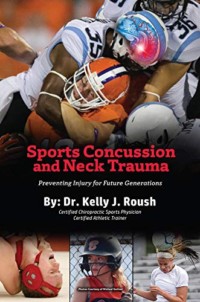Title: Sports Concussion and Neck Trauma: Preventing Injury for Future Generations
Author: Dr. Kelly J. Roush
Publisher: Lime Press, LLC
ISBN: 978-1-954304-49-9
Pages: 192
Genre: Sports Medicine
Reviewed by: Jason Lulos
Pacific Book Review
Since the NFL found itself in a time of reckoning regarding concussions and Chronic Traumatic encephalopathy (CTE), they have rightly been directed attention to all sports with a growing focus on children’s safety. In Sports Concussion and Neck Trauma: Preventing Injury for Future Generations, Dr. Kelly Roush details the definition, diagnosis, prevention, and treatment of head and neck injuries. Dr. Roush is a Certified Chiropractic Sports Physician and Athletic Trainer. She is clearly passionate, extremely knowledgeable, and has designed this book as guidance for athletes of all ages to be as safe as possible.
Dr. Roush notes that playing a sport is no different from riding in a car. In either case, one must be educated on the rules, safety precautions, physical requirements, and proper techniques in order to minimize the possibility of injury. Thus, the book is not meant to instill fear of getting hurt, but rather to educate readers on how to be safe. The author’s commitment to safety is matched by her love of sports.
Dr. Roush covers everything from cheerleading to football to bobsledding. One of the real eye-openers is that concussions can come from repeated, minor bumps to the head: not just powerful, single hits. The head jostling that bobsledders experience is one such example. Regarding prevention, helmets are obviously an important subject here. In the book, Dr. Roush interviews Dr. Julian Bailes (portrayed by Alec Baldwin in the movie Concussion). In this enlightening and wide-ranging dialogue, they discuss how the internal cushioning of a helmet is analogous to the use of airbags in a car. This and the innovative Q Collar are some of the fascinating looks at the development of safety and technology in the book.
Concerning youth sports, Dr. Roush’s approach to preventative measures is holistic. She recommends vision training, proper rest, proper technique, physical fitness, and perhaps even chiropractic sessions as sensible prerequisites for anyone engaging in contact sports. Since many schools cannot afford a trainer (let alone computer diagnostics), Dr. Roush provides written analyses/tests for dealing with such injuries. She adds that knowing the athlete’s baseline will also help to evaluate their status if and when a head or neck injury were to occur.
This book also has great information on the roles of medical professionals and trainers. Dr. Roush explains how to make on-the-field assessments following injury. She discusses many different types of head/neck injuries and what to expect in terms of treatment: when to return to the field, physical therapy, and potential benefits of supplements like turmeric. Her medical explanations are thorough and well organized but also put in layperson’s terms, and thus easy to read.
This book is extraordinarily informative. Also included are interviews with former NFL player Mike Bartrum, helmet designer and Rodney Zide, Olympic Bronze medalist Doug Sharp (bobsledder); the history of safety legislation; and personal stories from children and adults who’ve suffered these kinds of injuries.
Sports Concussion and Neck Trauma: Preventing Injury for Future Generations is an indispensable guidebook on this subject. I definitely recommend it as a valuable resource for athletes, coaches, trainers, officials, medical professionals, and certainly parents whose children are involved in athletics.


